Decorative protective screens for radiators: understand the
Not all water heaters have a proper appearance, which would be in perfect harmony with all the details of the interior of a residential apartment, so during the renovation, many homeowners are trying to fix this deficiency on their own. In most cases, for these purposes they buy ready-made, or make home-made screens for radiators with their own hands from various building and finishing materials.
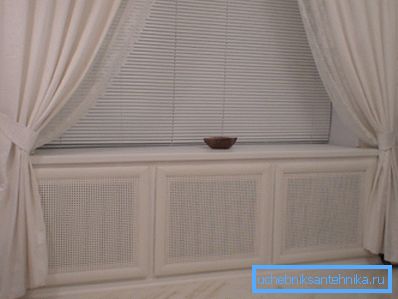
Overview of radiator screens
At the present time, various screens on radiators are presented in the sale of a fairly wide range of products, and the price of finished products mainly depends on the material from which they are made. This allows any apartment owner to easily choose the most suitable option for themselves, in accordance with the general concept of home decoration, as well as based on their own taste and personal preferences.
In order to make it easier for the reader to deal with this issue, this article will provide instructions that briefly describe various screens for a battery for heating, made of various materials, and also indicate their main advantages and disadvantages.
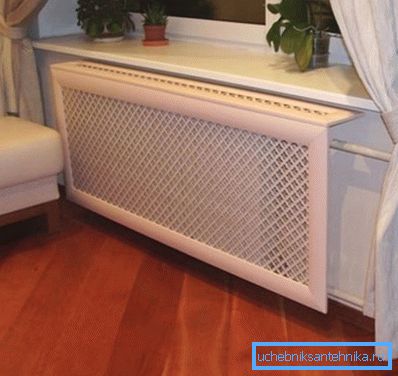
Varieties of decorative screens
All decorative and protective screens for a heating battery, regardless of the material from which they are made, can be divided into several types, which differ in the design and installation method, so the choice is made depending on the specific installation conditions.
- Flat protective grilles They are the simplest option used to decorate batteries and radiators installed in niches or hidden cavities.
- Grille without cover They are an easily removable structure, which is most often used for decorating old cast-iron accordion-type batteries that are installed in the window sills.
- Grilles with top cover They are a modernized look of the previous construction, since they have a horizontal plane, which makes it possible to close water radiators and old cast-iron batteries protruding from the window sill.
- Volumetric decorative and protective lattices in the form of a four-sided attached box represent a full screen on the heating battery, which completely covers it from all visible sides.
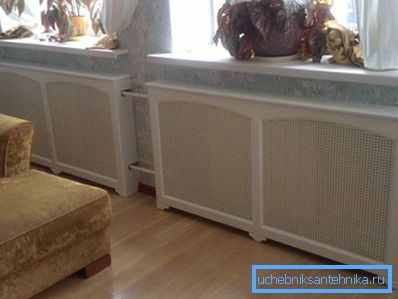
Tip! If small children live in the house, it is best to use a three-dimensional structure that covers the radiator from all sides, since this will significantly reduce its risk of injury.
Metal screens
In most cases, the simplest metal screen for a heating battery is a closed or half-open box-shaped structure made of perforated or perforated thin-walled sheet metal, which is attached directly to the heating radiator, or installed separately, using its own mounting brackets.
More expensive models can be made of polished or brushed stainless steel, as well as sheet aluminum, and the classic series models, at a lower cost, made of ferrous metal coated with powder-colored polyester enamel.
The main advantages of metal protective and decorative grilles include the following characteristics of the majority of such models:
- Good thermal conductivity of the metal provides a high level of heat transfer, which minimizes heat loss when installing such devices.
- The closed box construction prevents the penetration of dust and small household garbage between the fins of the battery, and also contributes to the convective movement of air masses around the heating radiator, thereby ensuring quick and uniform heating of the air throughout the room.
- The high strength of the metal ensures the reliability of the design, and additional protection of the external fins of the radiator from mechanical damage, therefore such a decorative screen of the radiator can be used both in residential buildings and in public places.
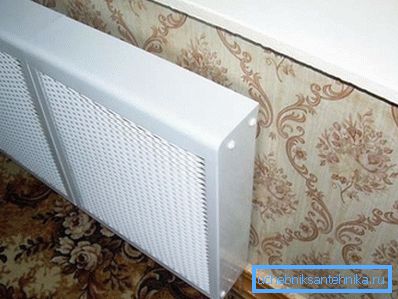
Decorative wood screens
Carved and openwork grilles of various wood species can be considered as the most suitable screen for radiators in residential and bedroom premises, since they are made of natural, environmentally friendly material that will harmonize with almost any style of housing.
Most often, such a screen on radiators is made from an array of precious woods, so it is quite expensive, but even this option has both advantages and disadvantages.
- Natural wood has a noble appearance, moreover, it is always pleasant to the touch, and in addition, it has an antistatic effect. It is easy to paint in any suitable color or tinted in the desired shade, while maintaining the texture of natural wood.
- Wood has a low thermal conductivity, so the screen on a cast iron radiator should have an open tracery structure in order to freely transmit thermal radiation.
- With constant temperature differences, the moisture structure in the wood structure changes, which leads to its deformation, therefore, over time, wood products may lose their shape or change their geometric dimensions, cracks may form in the array, and cracks may occur between the structural details.
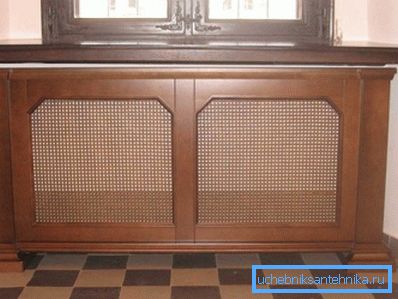
Tip! As a front panel of the decorative grille, it is good to use ready-made wicker elements from natural wood materials, such as wicker, rattan or young bamboo shoots. Due to their flexibility, they keep their shape well, and practically do not deform over time.
Interior solutions from modern materials
Along with the listed options, lately, various screens for cast-iron radiators and modern bimetallic radiators, made of materials that are not typical for this type of product, are often used.
For a brief introduction, the following will be presented the most common types of materials, of which factory or home-made decorative protective screens for heating radiators are most often made.
- Factory plastic grilles of various polymeric materials are the most inexpensive option to design a radiator. They are available in various sizes and can have a different configuration of holes for air circulation, but they are not recommended for use in residential and sleeping areas, as they have a static effect, and when heated can produce harmful substances.
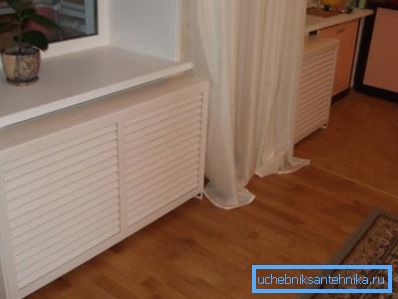
- The most optimal in terms of price and quality, are decorative grilles made of MDF, which at first glance are difficult to distinguish from natural wood, but the cost of such products is significantly lower. In addition to the reasonable price and high aesthetic properties, this material lends itself well to mechanical processing, and besides it possesses high performance qualities.

- In residential and office premises, designed in a modernist style, it will be appropriate to use glass panels made of safety tempered glass with a thickness of 8-10 mm. They have high mechanical strength, absolute environmental cleanliness and good thermal conductivity, and also have an elegant appearance, so they will be well combined with modern convectors for heating systems, as well as with aluminum or bimetallic radiators of small cross section.
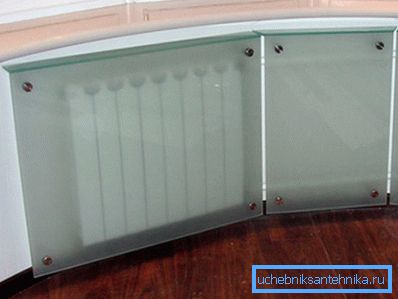
Tip! A prerequisite for the manufacture of glass screens is the use of tempered glass, which is confirmed by the presence of a special decal on its surface, which is applied by the manufacturer of glass products.
Conclusion
Finally, it should be noted that for installation in homes and apartments, and especially in bedrooms and children's rooms, it is best to use environmentally friendly and time-tested wooden screens for radiators, which can be ordered according to individual sizes, or made with your own hands in a home workshop.
To get an idea of how to do this, you can watch the video at the end of this article, or read similar materials on our website.